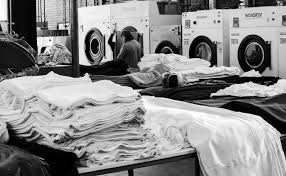The silent hero of any residential complex, fitness centre or accommodation facility isn’t always what you’d expect. It’s not the fancy gym or sparkling lobby. It’s the laundry room. And more often than not, it’s overlooked—until machines break down, towels go missing, or mould creeps into the corners.
Good Laundry Room Management isn’t about expensive refits. It’s about smart systems, preventative planning, and efficient use of existing infrastructure. Here’s how operators across Australia are upgrading their laundry services without blowing the budget.
The Hidden Cost of Poor Laundry Management
Imagine this: a gym in suburban Melbourne has a membership churn rate of 28%. Surveys show members regularly complain about sweaty towels, dirty lockers, and a “gross” smell near the change rooms. The culprit? A mismanaged laundry cycle.
Poorly run laundry systems cost more than time—they affect reputation, retention, and revenue.
This is why facilities from short-stay apartments to large retirement homes are finally investing in Laundry Room Management. Not through pricey automation, but by tightening operations and rethinking the basics.
Start with the Cycle: How Often is Too Often?
Overwashing is one of the biggest hidden costs. It wears out linen faster, drives up energy bills, and wastes water. On the flip side, underwashing leads to hygiene risks, especially in shared or high-traffic environments.
Operators are now adopting smart scheduling systems to create leaner, cleaner laundry routines. Instead of defaulting to daily cycles, many are introducing linen use tracking, load sensors, and predictive cleaning schedules. These small changes slash waste and keep standards high.
You don’t need cutting-edge AI to do this. A whiteboard, a weekly usage log, and a quick staff debrief can work wonders. That’s the kind of simplicity that defines strong Laundry Room Management.
Space Doesn’t Equal Efficiency
Most laundry rooms weren’t designed by people who actually do laundry. They’re often cramped, humid, and short on storage. But space isn’t everything—flow matters more.
The golden rule? Reduce double handling.
Map your layout so that dirty linen comes in through one door, and clean linen exits through another. Use wheeled tubs, colour-coded hampers, and vertical racks. Make it physically easier for staff to separate, clean, and restock linen without constantly moving back and forth.
One Sydney-based care facility reduced their turnover time by 40% just by repositioning benches and hanging bags above washers instead of beside them.
Invest Where It Counts: Durable, Not Deluxe
Upgrading equipment doesn’t mean installing gold-plated washers. It means choosing machines that can take a beating and are easy to service.
Look for:
- High-G-force washers to reduce drying times
- Machines with self-cleaning or chemical injection systems
- Front-loading machines with intuitive interfaces to reduce training time
Opt for fewer, better machines over many cheap ones. And schedule maintenance religiously—don’t wait for breakdowns.
For those managing multiple buildings or routes, consider outsourcing to professionals who specialise in Laundry Room Management. This approach allows operators to scale without infrastructure headaches. It’s why more multi-site venues are shifting to decentralised service models supported by mobile laundry operators.
Tracking Matters More Than You Think
A staggering number of towels and sheets vanish every year in shared spaces. Theft isn’t always the cause—misplacement and overuse are just as likely.
Institutions are now tagging linen using barcode or RFID systems. This helps track usage rates, replacement cycles, and even internal misuse.
But you don’t need expensive tech to start tracking. Numbered shelf systems, linen sign-out sheets, and even daily photo logs are simple low-cost alternatives.
Smart Laundry Room Management is about gaining visibility into how your linen is used—not just how it’s cleaned.
Sustainability Isn’t Just About Greenwashing
Energy efficiency matters to your bottom line. Heat-recovery dryers, cold-water detergents, and solar-assisted systems aren’t just for eco-marketing—they cut operating costs significantly.
In fact, this Clean Energy Council report shows that businesses using solar-assisted systems for laundry have slashed electricity bills by up to 35% annually.
Even small upgrades like LED lighting, timer-based ventilation fans, or replacing rubber seals can contribute to lower emissions and operational savings.
Combine that with smarter scheduling and better equipment care, and you’re not just saving money—you’re running a more responsible operation.
Training is the X-Factor
Many facilities upgrade equipment but forget the human element. Untrained staff often overfill machines, use the wrong cycles, or mismanage detergent levels—undoing every other improvement.
Operators should treat laundry like any other skill area. Provide regular refresher sessions, create laminated cheat sheets near machines, and run quality checks.
This kind of hands-on approach is what separates average operators from those who truly understand Laundry Room Management.
Recap: Smarter Laundry, Happier Guests
You don’t need a big budget to run an efficient, hygienic, and guest-friendly laundry system. You need:
- Purposeful scheduling
- Thoughtful layout design
- Durable equipment
- Simple tracking systems
- Energy-conscious upgrades
- And most importantly, trained staff
These are the foundations of modern Laundry Room Management—and they’re within reach for operators across Australia.
If you’re managing multiple properties, shared facilities, or just want to cut costs without cutting corners, this is where it starts.
Let your laundry do the talking—quietly, efficiently, and without drama.
Need more insight into how other operators are staying ahead? Discover expert tips on Laundry Room Management, see how route-based services are transforming hygiene standards Laundry Room Management, and explore scalable solutions for your business today Laundry Room Management.

